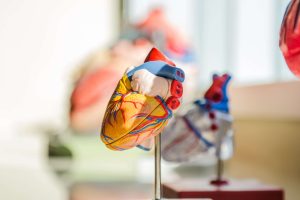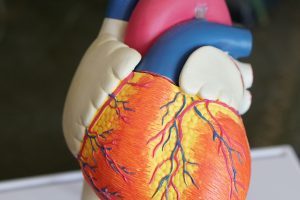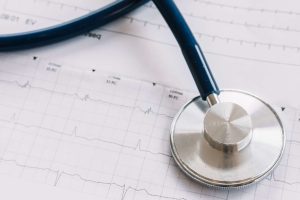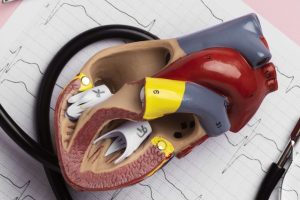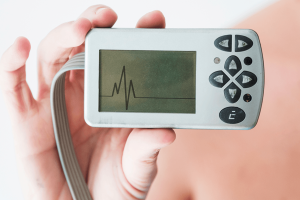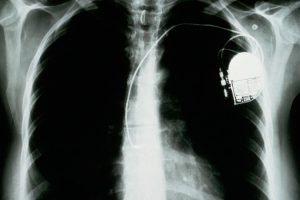The heart never takes a break. The heart is a strong muscle that never stops exercising, not for a minute. Every minute it needs blood, nourishment and oxygen. At Amarillo Heart Institute, we understand the importance of keeping your heart healthy and functioning at its best. We believe that a healthy heart is the foundation of a healthy life, and our goal is to provide you with all you need to achieve optimal heart health, a happier heart.
Electrocardiogram & Stress Electrocardiography
Electrocardiogram (ECG)
Electrocardiogram (ECG) is a medical test that records the electrical activity of the heart. It is a non-invasive test that involves attaching electrodes to the skin on the chest, arms, and legs. The electrodes detect the electrical signals generated by the heart and transmit them to a machine, which records them as waves on a graph.
The waves on the ECG graph represent the different stages of the cardiac cycle, which is the process of the heart contracting and relaxing to pump blood throughout the body. The ECG can provide information about the heart’s rhythm, rate, and overall function, and can help diagnose a variety of heart conditions, including arrhythmias, heart attacks, and heart failure.
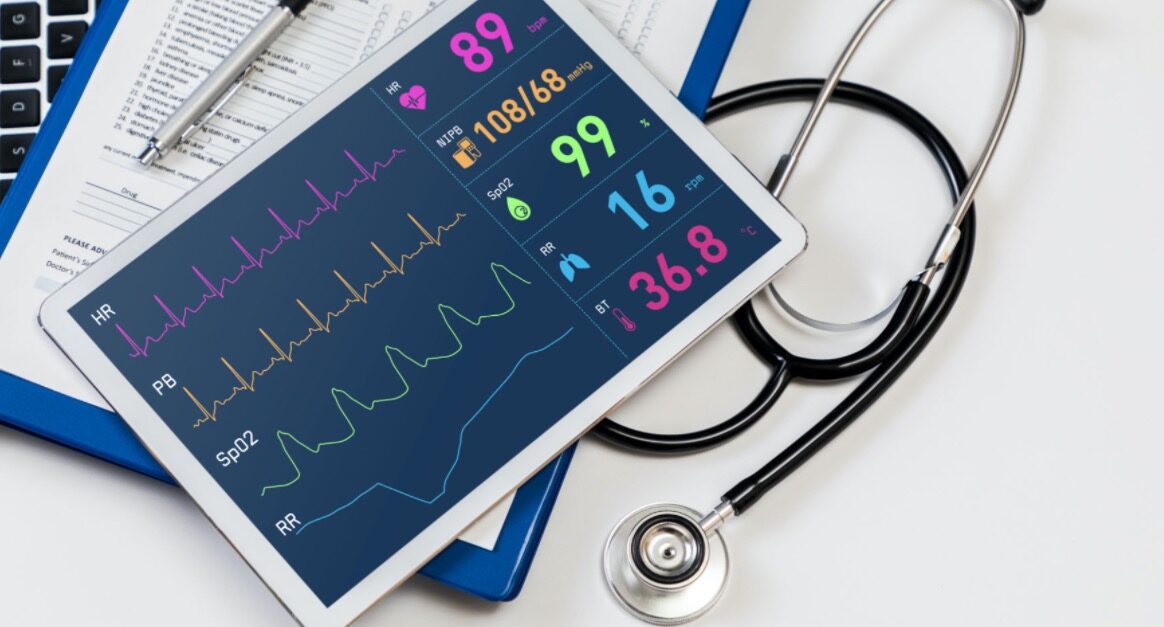
Electrocardiogram (ECG) is a medical test that records the electrical activity of the heart. It is a non-invasive test that involves attaching electrodes to the skin on the chest, arms, and legs. The electrodes detect the electrical signals generated by the heart and transmit them to a machine, which records them as waves on a graph.
The waves on the ECG graph represent the different stages of the cardiac cycle, which is the process of the heart contracting and relaxing to pump blood throughout the body. The ECG can provide information about the heart’s rhythm, rate, and overall function, and can help diagnose a variety of heart conditions, including arrhythmias, heart attacks, and heart failure.

Electrocardiogram (ECG) Uses
Electrocardiogram (ECG) can be used to diagnose a variety of heart diseases and conditions, including:
Arrhythmias: ECG can detect irregular heartbeats, such as atrial fibrillation, ventricular tachycardia, and bradycardia.
Coronary artery disease (CAD): ECG can show signs of decreased blood flow to the heart, such as ST-segment depression or elevation.
Heart attacks (myocardial infarction): ECG can show changes in the heart’s electrical activity that occur during a heart attack, such as ST-segment elevation.
Cardiomyopathy: ECG can detect changes in the size or shape of the heart, as well as abnormalities in the heart’s electrical activity.
Heart failure: ECG can show signs of reduced heart function, such as a low ejection fraction or an enlarged heart.
Valvular heart disease: ECG can detect abnormalities in the heart’s electrical activity that may be associated with valve problems, such as atrial fibrillation or ventricular hypertrophy.
Electrocardiogram Characteristics
ECG measures the electrical activity of the heart: The heart generates electrical impulses that control the timing and coordination of the heart’s contraction and relaxation. ECG records these electrical impulses and displays them as a series of waveforms.
ECG is a non-invasive test: Electrodes are placed on the skin of the chest, arms, and legs, and the electrical signals are detected and transmitted to a machine, which records them as waveforms on a graph. The test is painless and does not involve any needles or injections.
ECG can detect a variety of heart conditions: ECG can provide information about the heart’s rhythm, rate, and overall function. It can detect abnormalities in the heart’s electrical activity that may be associated with a variety of heart conditions, including arrhythmias, heart attacks, and heart failure.
ECG is often performed as part of a routine physical exam: ECG is a common test that is often performed as part of a routine physical exam, especially for patients who are at risk for heart disease or who have symptoms that may be associated with heart problems.
ECG is usually interpreted by a healthcare professional: The waveforms on the ECG graph can be complex and difficult to interpret, so ECG is usually analyzed by a healthcare professional, such as a cardiologist or a specially trained technician.
ECG may be used in combination with other tests: ECG is often used in combination with other tests, such as echocardiography or stress testing, to provide a more complete picture of the heart’s function and to aid in diagnosis and treatment planning.
Overall, ECG is a useful and widely used diagnostic tool that can provide valuable information about the heart’s electrical activity and function.
Electrocardiogram (ECG) Uses
Electrocardiogram (ECG) can be used to diagnose a variety of heart diseases and conditions, including:
Arrhythmias: ECG can detect irregular heartbeats, such as atrial fibrillation, ventricular tachycardia, and bradycardia.
Coronary artery disease (CAD): ECG can show signs of decreased blood flow to the heart, such as ST-segment depression or elevation.
Heart attacks (myocardial infarction): ECG can show changes in the heart’s electrical activity that occur during a heart attack, such as ST-segment elevation.
Cardiomyopathy: ECG can detect changes in the size or shape of the heart, as well as abnormalities in the heart’s electrical activity.
Heart failure: ECG can show signs of reduced heart function, such as a low ejection fraction or an enlarged heart.
Valvular heart disease: ECG can detect abnormalities in the heart’s electrical activity that may be associated with valve problems, such as atrial fibrillation or ventricular hypertrophy.
Electrocardiogram Characteristics
ECG measures the electrical activity of the heart: The heart generates electrical impulses that control the timing and coordination of the heart’s contraction and relaxation. ECG records these electrical impulses and displays them as a series of waveforms.
ECG is a non-invasive test: Electrodes are placed on the skin of the chest, arms, and legs, and the electrical signals are detected and transmitted to a machine, which records them as waveforms on a graph. The test is painless and does not involve any needles or injections.
ECG can detect a variety of heart conditions: ECG can provide information about the heart’s rhythm, rate, and overall function. It can detect abnormalities in the heart’s electrical activity that may be associated with a variety of heart conditions, including arrhythmias, heart attacks, and heart failure.
ECG is often performed as part of a routine physical exam: ECG is a common test that is often performed as part of a routine physical exam, especially for patients who are at risk for heart disease or who have symptoms that may be associated with heart problems.
ECG is usually interpreted by a healthcare professional: The waveforms on the ECG graph can be complex and difficult to interpret, so ECG is usually analyzed by a healthcare professional, such as a cardiologist or a specially trained technician.
ECG may be used in combination with other tests: ECG is often used in combination with other tests, such as echocardiography or stress testing, to provide a more complete picture of the heart’s function and to aid in diagnosis and treatment planning.
Overall, ECG is a useful and widely used diagnostic tool that can provide valuable information about the heart’s electrical activity and function.
Stress Electrocardiography or Stress Test
Stress electrocardiography (also known as a stress test or exercise ECG) is a type of ECG that is performed while the patient is exercising or under stress. The purpose of the test is to evaluate the heart’s response to increased levels of physical activity and stress.
During the test, the patient typically walks on a treadmill or pedals a stationary bike while their heart rate and blood pressure are monitored. The ECG is recorded before, during, and after exercise to detect any changes in the heart’s electrical activity or blood flow.
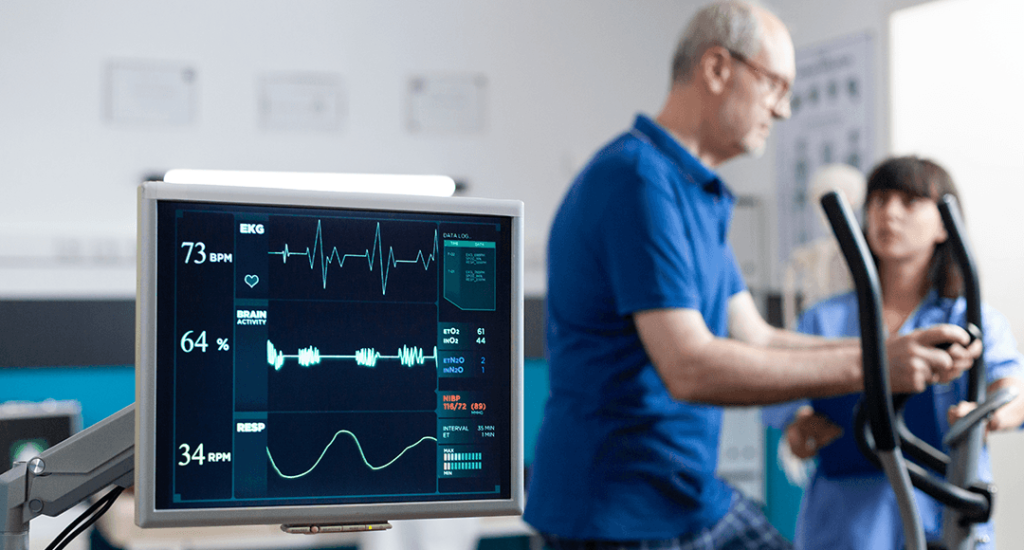
Stress electrocardiography (also known as a stress test or exercise ECG) is a type of ECG that is performed while the patient is exercising or under stress. The purpose of the test is to evaluate the heart’s response to increased levels of physical activity and stress.
During the test, the patient typically walks on a treadmill or pedals a stationary bike while their heart rate and blood pressure are monitored. The ECG is recorded before, during, and after exercise to detect any changes in the heart’s electrical activity or blood flow.

Stress Electrocardiography uses
It is often used in the assessment and management of various heart conditions, including:
Coronary artery disease (CAD): Stress electrocardiography is frequently used to diagnose CAD, which occurs when the arteries that supply blood to the heart become narrow or blocked. During the test, the patient exercises on a treadmill or stationary bike, which causes the heart to work harder and consume more oxygen. The test can detect changes in the ECG pattern that suggest inadequate blood flow to the heart muscle, which can be a sign of CAD.
Heart failure: Stress electrocardiography can be used to evaluate the effectiveness of treatment for heart failure and to assess the heart’s ability to pump blood during physical activity.
Arrhythmias: Stress electrocardiography can help diagnose arrhythmias that may be provoked by exercise, such as atrial fibrillation or ventricular tachycardia.
Valvular heart disease: Stress electrocardiography can detect abnormalities in the heart’s electrical activity that may be associated with valve problems, such as atrial fibrillation or ventricular hypertrophy.
Cardiomyopathy: Stress electrocardiography can be used to assess the heart’s ability to function during physical activity in patients with cardiomyopathy, a condition that affects the heart muscle.
Stress electrocardiography can also be used to monitor the effects of medications and lifestyle changes on heart function and to guide decisions about further testing or treatment. Overall, stress electrocardiography is a useful tool in the management of a variety of heart conditions and can help healthcare providers make more informed decisions about patient care.
Stress Electrocardiography/Stress Test
Stress ECG measures the heart’s response to physical activity: During a stress ECG, the patient exercises on a treadmill or stationary bike while their heart rate, blood pressure, and ECG are monitored. The level of physical activity is gradually increased to progressively stress the heart.
Stress ECG is used to diagnose heart conditions: Stress ECG can help diagnose heart conditions that may not be evident during rest, such as coronary artery disease, heart failure, or arrhythmias.
Stress ECG can reveal abnormal ECG patterns: Stress ECG can detect changes in the ECG pattern that may indicate reduced blood flow to the heart, irregular heartbeats, or other abnormalities.
Stress ECG can be used to monitor treatment: Stress ECG can be used to monitor the effectiveness of medications, lifestyle changes, or other interventions in patients with heart conditions.
Stress ECG can help determine the level of physical activity a patient can safely tolerate: In some cases, stress ECG can be used to determine the level of physical activity that a patient can safely tolerate, such as after a heart attack or heart surgery.
Stress ECG is usually performed in a clinical setting: Stress ECG is typically performed in a clinical setting, such as a hospital or outpatient clinic, and is supervised by a healthcare professional, such as a cardiologist or a specially trained technician.
Overall, stress ECG is a useful diagnostic tool that can provide important information about the heart’s response to physical activity and stress. It can help diagnose and monitor a variety of heart conditions, guide treatment decisions, and promote safe physical activity for patients with heart disease.
Stress Electrocardiography uses
It is often used in the assessment and management of various heart conditions, including:
Coronary artery disease (CAD): Stress electrocardiography is frequently used to diagnose CAD, which occurs when the arteries that supply blood to the heart become narrow or blocked. During the test, the patient exercises on a treadmill or stationary bike, which causes the heart to work harder and consume more oxygen. The test can detect changes in the ECG pattern that suggest inadequate blood flow to the heart muscle, which can be a sign of CAD.
Heart failure: Stress electrocardiography can be used to evaluate the effectiveness of treatment for heart failure and to assess the heart’s ability to pump blood during physical activity.
Arrhythmias: Stress electrocardiography can help diagnose arrhythmias that may be provoked by exercise, such as atrial fibrillation or ventricular tachycardia.
Valvular heart disease: Stress electrocardiography can detect abnormalities in the heart’s electrical activity that may be associated with valve problems, such as atrial fibrillation or ventricular hypertrophy.
Cardiomyopathy: Stress electrocardiography can be used to assess the heart’s ability to function during physical activity in patients with cardiomyopathy, a condition that affects the heart muscle.
Stress electrocardiography can also be used to monitor the effects of medications and lifestyle changes on heart function and to guide decisions about further testing or treatment. Overall, stress electrocardiography is a useful tool in the management of a variety of heart conditions and can help healthcare providers make more informed decisions about patient care.
Stress Electrocardiography/Stress Test
Stress ECG measures the heart’s response to physical activity: During a stress ECG, the patient exercises on a treadmill or stationary bike while their heart rate, blood pressure, and ECG are monitored. The level of physical activity is gradually increased to progressively stress the heart.
Stress ECG is used to diagnose heart conditions: Stress ECG can help diagnose heart conditions that may not be evident during rest, such as coronary artery disease, heart failure, or arrhythmias.
Stress ECG can reveal abnormal ECG patterns: Stress ECG can detect changes in the ECG pattern that may indicate reduced blood flow to the heart, irregular heartbeats, or other abnormalities.
Stress ECG can be used to monitor treatment: Stress ECG can be used to monitor the effectiveness of medications, lifestyle changes, or other interventions in patients with heart conditions.
Stress ECG can help determine the level of physical activity a patient can safely tolerate: In some cases, stress ECG can be used to determine the level of physical activity that a patient can safely tolerate, such as after a heart attack or heart surgery.
Stress ECG is usually performed in a clinical setting: Stress ECG is typically performed in a clinical setting, such as a hospital or outpatient clinic, and is supervised by a healthcare professional, such as a cardiologist or a specially trained technician.
Overall, stress ECG is a useful diagnostic tool that can provide important information about the heart’s response to physical activity and stress. It can help diagnose and monitor a variety of heart conditions, guide treatment decisions, and promote safe physical activity for patients with heart disease.

